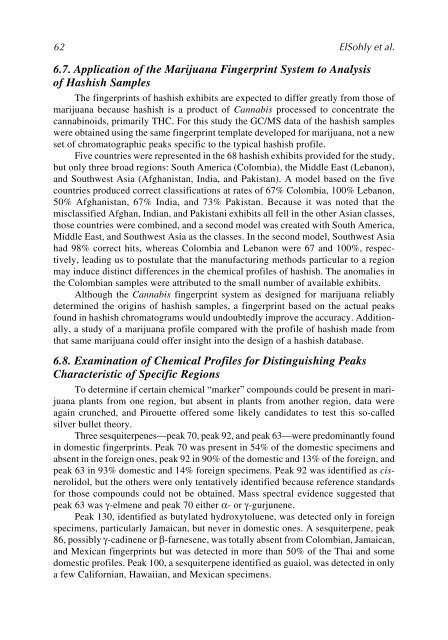Marijuana and the Cannabinoids
Marijuana and the Cannabinoids
Marijuana and the Cannabinoids
Create successful ePaper yourself
Turn your PDF publications into a flip-book with our unique Google optimized e-Paper software.
62 ElSohly et al.<br />
6.7. Application of <strong>the</strong> <strong>Marijuana</strong> Fingerprint System to Analysis<br />
of Hashish Samples<br />
The fingerprints of hashish exhibits are expected to differ greatly from those of<br />
marijuana because hashish is a product of Cannabis processed to concentrate <strong>the</strong><br />
cannabinoids, primarily THC. For this study <strong>the</strong> GC/MS data of <strong>the</strong> hashish samples<br />
were obtained using <strong>the</strong> same fingerprint template developed for marijuana, not a new<br />
set of chromatographic peaks specific to <strong>the</strong> typical hashish profile.<br />
Five countries were represented in <strong>the</strong> 68 hashish exhibits provided for <strong>the</strong> study,<br />
but only three broad regions: South America (Colombia), <strong>the</strong> Middle East (Lebanon),<br />
<strong>and</strong> Southwest Asia (Afghanistan, India, <strong>and</strong> Pakistan). A model based on <strong>the</strong> five<br />
countries produced correct classifications at rates of 67% Colombia, 100% Lebanon,<br />
50% Afghanistan, 67% India, <strong>and</strong> 73% Pakistan. Because it was noted that <strong>the</strong><br />
misclassified Afghan, Indian, <strong>and</strong> Pakistani exhibits all fell in <strong>the</strong> o<strong>the</strong>r Asian classes,<br />
those countries were combined, <strong>and</strong> a second model was created with South America,<br />
Middle East, <strong>and</strong> Southwest Asia as <strong>the</strong> classes. In <strong>the</strong> second model, Southwest Asia<br />
had 98% correct hits, whereas Colombia <strong>and</strong> Lebanon were 67 <strong>and</strong> 100%, respectively,<br />
leading us to postulate that <strong>the</strong> manufacturing methods particular to a region<br />
may induce distinct differences in <strong>the</strong> chemical profiles of hashish. The anomalies in<br />
<strong>the</strong> Colombian samples were attributed to <strong>the</strong> small number of available exhibits.<br />
Although <strong>the</strong> Cannabis fingerprint system as designed for marijuana reliably<br />
determined <strong>the</strong> origins of hashish samples, a fingerprint based on <strong>the</strong> actual peaks<br />
found in hashish chromatograms would undoubtedly improve <strong>the</strong> accuracy. Additionally,<br />
a study of a marijuana profile compared with <strong>the</strong> profile of hashish made from<br />
that same marijuana could offer insight into <strong>the</strong> design of a hashish database.<br />
6.8. Examination of Chemical Profiles for Distinguishing Peaks<br />
Characteristic of Specific Regions<br />
To determine if certain chemical “marker” compounds could be present in marijuana<br />
plants from one region, but absent in plants from ano<strong>the</strong>r region, data were<br />
again crunched, <strong>and</strong> Pirouette offered some likely c<strong>and</strong>idates to test this so-called<br />
silver bullet <strong>the</strong>ory.<br />
Three sesquiterpenes—peak 70, peak 92, <strong>and</strong> peak 63—were predominantly found<br />
in domestic fingerprints. Peak 70 was present in 54% of <strong>the</strong> domestic specimens <strong>and</strong><br />
absent in <strong>the</strong> foreign ones, peak 92 in 90% of <strong>the</strong> domestic <strong>and</strong> 13% of <strong>the</strong> foreign, <strong>and</strong><br />
peak 63 in 93% domestic <strong>and</strong> 14% foreign specimens. Peak 92 was identified as cisnerolidol,<br />
but <strong>the</strong> o<strong>the</strong>rs were only tentatively identified because reference st<strong>and</strong>ards<br />
for those compounds could not be obtained. Mass spectral evidence suggested that<br />
peak 63 was γ-elmene <strong>and</strong> peak 70 ei<strong>the</strong>r α- or γ-gurjunene.<br />
Peak 130, identified as butylated hydroxytoluene, was detected only in foreign<br />
specimens, particularly Jamaican, but never in domestic ones. A sesquiterpene, peak<br />
86, possibly γ-cadinene or β-farnesene, was totally absent from Colombian, Jamaican,<br />
<strong>and</strong> Mexican fingerprints but was detected in more than 50% of <strong>the</strong> Thai <strong>and</strong> some<br />
domestic profiles. Peak 100, a sesquiterpene identified as guaiol, was detected in only<br />
a few Californian, Hawaiian, <strong>and</strong> Mexican specimens.


